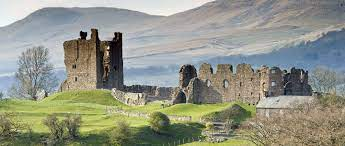Lady Anne Clifford was born in 1590, the only surviving child of George Clifford, third Earl of Cumberland; the scion of a family powerful in the north-west of England since the thirteenth century, and as a young girl she was presented at the court of Queen Elizabeth I. She was twice married; first to Richard Sackville, Earl of Dorset, by whom she had two daughters, and later to Philip Herbert, Earl of Pembroke. She does not appeared to have had any great joy in either marriage, and despite living in the great age of the Elizabethan and early Stuart Renaissance, her heart was always in the north of England and her outlook resolutely mediaeval.
(This triptych shows, in the centre, Sir George Clifford and his family, with, on the left, Lady Anne as a child and, on the right, as a mature lady in her fifties)
Much to Lady Anne's disgust, her father, when he died in 1605, left his lands and property not to her but to his brother Francis, who became fourth Earl of Cumberland, and it was only when his son, Henry, the fifth Earl, died childless in 1643 that she was able to inherit what she had always seen as her rightful possessions. But at this stage the Civil War intervened, and it was only when the fighting had ceased that she was able to begin the restoration of her castles, where she was to live for the rest of her life. Her contemporaries knew her as a "proud northern lady".
Lady Anne Clifford's castles today:-
Brougham castle, on the river Eamont, near Penrith
Appleby castle: the only one still in private hands
Brough castle: situated on the A66 road several miles south-east from Penrith
The Countess's Pillar: a short distance from Brougham on the road to Appleby. She erected it in memory of her mother, and arranged for charity to distributed from this site every April to the poor of the parish.
The coat of arms of Sir George Clifford, Earl of Cumberland: Lady Anne Clifford's father
Lady Anne Clifford died at Brougham in 1676. In 1714 her son-in-law, John Tufton, Earl of Thanet, sold Brougham and Brough castles, which were then stripped of everything valuable and allowed to fall into ruin. They are now both under the administration of English Heritage.







No comments:
Post a Comment